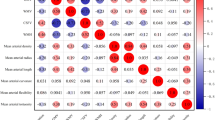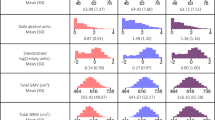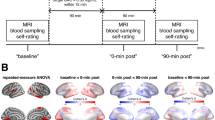Abstract
Components of the corticocerebellar circuit and the midbrain individually play a central role in addictive processes and have been associated with altered volumes and impairment of cognitive flexibility in alcohol-dependent subjects. The microstructure of white matter bundles composing the corticocerebellar network and passing through the midbrain was studied using diffusion tensor imaging in a group of detoxified alcohol-dependent men (n=20) and a group of healthy men (n=24). The relationship between properties of these white matter bundles and cognitive flexibility performance was investigated in alcohol-dependent subjects. Bundles connecting two regions of interest were analyzed using a fiber-tracking quantitative approach, which provided estimates of the fractional anisotropy and the apparent diffusion coefficient, as well as the number of tracked fibers normalized by the volume of regions of interest. Within the bundles running between the midbrain and pons, a mean of 18% fewer fibers per unit volume were tracked in alcohol-dependent men than in healthy controls. In addition, the normalized number of these fibers correlated with the performance in the Trail-Making Test part-B. Even though the alcohol-dependent subjects were detoxified and apparently neurologically intact, their earlier excessive use of alcohol seems to be associated with altered neural microstructure of mesencephalic white matter bundles, which may contribute to their cognitive flexibility impairment.
Similar content being viewed by others
Log in or create a free account to read this content
Gain free access to this article, as well as selected content from this journal and more on nature.com
or
References
Annett M (1967). The binomial distribution of right, mixed and left handedness. Q J Exp Psychol 19: 327–333.
Arango V, Underwood MD, Mann JJ (1994). Fewer pigmented neurons in the locus coeruleus of uncomplicated alcoholics. Brain Res 650: 1–8.
Arria AM, Tarter RE, Starzl TE, Van Thiel DH (1991). Improvement in cognitive functioning of alcoholics following orthotopic liver transplantation. Alcohol Clin Exp Res 15: 956–962.
Baker KG, Harding AJ, Halliday GM, Kril JJ, Harper CG (1999). Neuronal loss in functional zones of the cerebellum of chronic alcoholics with and without Wernicke's encephalopathy. Neuroscience 91: 429–438.
Behrens TE, Johansen-Berg H, Woolrich MW, Smith SM, Wheeler-Kingshott CA, Boulby PA et al (2003). Non-invasive mapping of connections between human thalamus and cortex using diffusion imaging. Nat Neurosci 6: 750–757.
Catani M (2006). Diffusion tensor magnetic resonance imaging tractography in cognitive disorders. Curr Opin Neurol 19: 599–606.
Catani M, Jones DK, Donato R, Ffytche DH (2003). Occipito-temporal connections in the human brain. Brain 126 (Part 9): 2093–2107.
Chanraud S, Martelli C, Delain F, Kostogianni N, Douaud G, Aubin HJ et al (2007). Brain morphometry and cognitive performance in detoxified alcohol-dependents with preserved psychosocial functioning. Neuropsychopharmacology 32: 429–438.
Cohen JA, Kaplan MM (1979). The SGOT/SGPT ratio—an indicator of alcoholic liver disease. Dig Dis Sci 24: 835–838.
Conturo TE, Lori NF, Cull TS, Akbudak E, Snyder AZ, Shimony JS et al (1999). Tracking neuronal fiber pathways in the living human brain. Proc Natl Acad Sci USA 96: 10422–10427.
Desmond JE, Chen SH, DeRosa E, Pryor MR, Pfefferbaum A, Sullivan EV (2003). Increased frontocerebellar activation in alcoholics during verbal working memory: an fMRI study. Neuroimage 19: 1510–1520.
Dubois J, Hertz-Pannier L, Dehaene-Lambertz G, Cointepas Y, Le Bihan D (2006a). Assessment of the early organization and maturation of infants’ cerebral white matter fiber bundles: a feasibility study using quantitative diffusion tensor imaging and tractography. Neuroimage 30: 1121–1132.
Dubois J, Poupon C, Lethimonnier F, Le Bihan D (2006b). Optimized diffusion gradient orientation schemes for corrupted clinical DTI data sets. Magma 19: 134–143.
Duka T, Townshend JM, Collier K, Stephens DN (2003). Impairment in cognitive functions after multiple detoxifications in alcoholic inpatients. Alcohol Clin Exp Res 27: 1563–1572.
Folstein MF, Folstein SE, McHugh PR (1975). ‘Mini-mental state’. A practical method for grading the cognitive state of patients for the clinician. J Psychiatr Res 12: 189–198.
Goldman MS (1990). Experience-dependent neuropsychological recovery and the treatment of chronic alcoholism. Neuropsychol Rev 1: 75–101.
Hagmann P, Thiran JP, Jonasson L, Vandergheynst P, Clarke S, Maeder P et al (2003). DTI mapping of human brain connectivity: statistical fibre tracking and virtual dissection. Neuroimage 19: 545–554.
Halliday G, Ellis J, Heard R, Caine D, Harper C (1993). Brainstem serotonergic neurons in chronic alcoholics with and without the memory impairment of Korsakoff's psychosis. J Neuropathol Exp Neurol 52: 567–579.
Harper C, Dixon G, Sheedy D, Garrick T (2003). Neuropathological alterations in alcoholic brains. Studies arising from the New South Wales Tissue Resource Centre. Prog Neuropsychopharmacol Biol Psychiatry 27: 951–961.
Harper C, Matsumoto I (2005). Ethanol and brain damage. Curr Opin Pharmacol 5: 73–78.
Houenou J, Wessa M, Douaud G, Leboyer M, Chanraud S, Perrin M et al (2007). Increased white matter connectivity in euthymic bipolar patients: diffusion tensor tractography between the subgenual cingulate and the amygdalo-hippocampal complex. Mol Psychiatry 1: 1.
Hyman SE, Malenka RC, Nestler EJ (2006). Neural mechanisms of addiction: the role of reward-related learning and memory. Annu Rev Neurosci 29: 565–598.
Johansen-Berg H, Behrens TE (2006). Just pretty pictures? What diffusion tractography can add in clinical neuroscience. Curr Opin Neurol 19: 379–385.
Kanaan RA, Shergill SS, Barker GJ, Catani M, Ng VW, Howard R et al (2006). Tract-specific anisotropy measurements in diffusion tensor imaging. Psychiatry Res 146: 73–82.
Kelly RM, Strick PL (2003). Cerebellar loops with motor cortex and prefrontal cortex of a nonhuman primate. J Neurosci 23: 8432–8444.
Koob GF (2003). Alcoholism: allostasis and beyond. Alcohol Clin Exp Res 27: 232–243.
Kril JJ, Halliday GM, Svoboda MD, Cartwright H (1997). The cerebral cortex is damaged in chronic alcoholics. Neuroscience 79: 983–998.
Lazar M, Weinstein DM, Tsuruda JS, Hasan KM, Arfanakis K, Meyerand ME et al (2003). White matter tractography using diffusion tensor deflection. Hum Brain Mapp 18: 306–321.
Le Bihan D, Mangin JF, Poupon C, Clark CA, Pappata S, Molko N et al (2001). Diffusion tensor imaging: concepts and applications. J Magn Reson Imaging 13: 534–546.
Meyerhoff DJ, Tizabi Y, Staley JK, Durazzo TC, Glass JM, Nixon SJ (2006). Smoking comorbidity in alcoholism: neurobiological and neurocognitive consequences. Alcohol Clin Exp Res 30: 253–264.
Morgenstern J, Longabaugh R (2000). Cognitive-behavioral treatment for alcohol dependence: a review of evidence for its hypothesized mechanisms of action. Addiction 95: 1475–1490.
Nieuwenhuys R, Voogd J, vanHuijzen C (1988). The Human Central Nervous System. A Synopsis and Atlas, 3rd rev edn. Springer-Verlag: Berlin.
Oscar-Berman M, Shagrin B, Evert DL, Epstein C (1997). Impairments of brain and behavior: the neurological effects of alcohol. Alcohol Health Res World 21: 65–75.
Perrin M, Poupon C, Rieul B, Leroux P, Constantinesco A, Mangin JF et al (2005). Validation of q-ball imaging with a diffusion fibre-crossing phantom on a clinical scanner. Philos Trans R Soc Lond B Biol Sci 360: 881–891.
Pfefferbaum A, Adalsteinsson E, Sullivan EV (2006). Supratentorial profile of white matter microstructural integrity in recovering alcoholic men and women. Biol Psychiatry 59: 364–372.
Pfefferbaum A, Desmond JE, Galloway C, Menon V, Glover GH, Sullivan EV (2001). Reorganization of frontal systems used by alcoholics for spatial working memory: an fMRI study. Neuroimage 14: 7–20.
Pfefferbaum A, Sullivan EV, Hedehus M, Adalsteinsson E, Lim KO, Moseley M (2000). In vivo detection and functional correlates of white matter microstructural disruption in chronic alcoholism. Alcohol Clin Exp Res 24: 1214–1221.
Pierpaoli C, Barnett A, Pajevic S, Chen R, Penix LR, Virta A et al (2001). Water diffusion changes in Wallerian degeneration and their dependence on white matter architecture. Neuroimage 13 (6 Part 1): 1174–1185.
Poupon C, Mangin J, Clark CA, Frouin V, Regis J, Le Bihan D et al (2001). Towards inference of human brain connectivity from MR diffusion tensor data. Med Image Anal 5: 1–15.
Reinert DF, Allen JP (2002). The Alcohol Use Disorders Identification Test (AUDIT): a review of recent research. Alcohol Clin Exp Res 26: 272–279.
Roehrich L, Goldman MS (1993). Experience-dependent neuropsychological recovery and the treatment of alcoholism. J Consult Clin Psychol 61: 812–821.
Schmahmann JD (2004). Disorders of the cerebellum: ataxia, dysmetria of thought, and the cerebellar cognitive affective syndrome. J Neuropsychiatry Clin Neurosci 16: 367–378.
Schmahmann JD, Ko R, MacMore J (2004). The human basis pontis: motor syndromes and topographic organization. Brain 127 (Part 6): 1269–1291.
Schmahmann JD, Pandya DN (1997). The cerebrocerebellar system. Int Rev Neurobiol 41: 31–60.
Schulte T, Muller-Oehring EM, Salo R, Pfefferbaum A, Sullivan EV (2006). Callosal involvement in a lateralized stroop task in alcoholic and healthy subjects. Neuropsychology 20: 727–736.
Sigman M, Dehaene S (2005). Parsing a cognitive task: a characterization of the mind's bottleneck. PLoS Biol 3: e37.
Sotak CH (2004). Nuclear magnetic resonance (NMR) measurement of the apparent diffusion coefficient (ADC) of tissue water and its relationship to cell volume changes in pathological states. Neurochem Int 45: 569–582.
Stieltjes B, Kaufmann WE, van Zijl PC, Fredericksen K, Pearlson GD, Solaiyappan M et al (2001). Diffusion tensor imaging and axonal tracking in the human brainstem. Neuroimage 14: 723–735.
Sullivan EV (2003). Compromised pontocerebellar and cerebellothalamocortical systems: speculations on their contributions to cognitive and motor impairment in nonamnesic alcoholism. Alcohol Clin Exp Res 27: 1409–1419.
Sullivan EV, Adalsteinsson E, Pfefferbaum A (2006). Selective age-related degradation of anterior callosal fiber bundles quantified in vivo with fiber tracking. Cereb Cortex 16: 1030–1039.
Sullivan EV, Deshmukh A, Desmond JE, Lim KO, Pfefferbaum A (2000). Cerebellar volume decline in normal aging, alcoholism, and Korsakoff's syndrome: relation to ataxia. Neuropsychology 14: 341–352.
Sullivan EV, Pfefferbaum A (2001). Magnetic resonance relaxometry reveals central pontine abnormalities in clinically asymptomatic alcoholic men. Alcohol Clin Exp Res 25: 1206–1212.
Sullivan EV, Rosenbloom M, Serventi KL, Pfefferbaum A (2004). Effects of age and sex on volumes of the thalamus, pons, and cortex. Neurobiol Aging 25: 185–192.
Sullivan EV, Rosenbloom MJ, Serventi KL, Deshmukh A, Pfefferbaum A (2003). Effects of alcohol dependence comorbidity and antipsychotic medication on volumes of the thalamus and pons in schizophrenia. Am J Psychiatry 160: 1110–1116.
Thompson-Schill SL (2003). Neuroimaging studies of semantic memory: inferring ‘how’ from ‘where’. Neuropsychologia 41: 280–292.
Wakana S, Jiang H, Nagae-Poetscher LM, van Zijl PC, Mori S (2004). Fiber tract-based atlas of human white matter anatomy. Radiology 230: 77–87.
Weissman MM, Bothwell S (1976). Assessment of social adjustment by patient self-report. Arch Gen Psychiatry 33: 1111–1115.
Zakzanis KK, Mraz R, Graham SJ (2005). An fMRI study of the Trail Making Test. Neuropsychologia 43: 1878–1886.
Acknowledgements
We thank Professor André Syrota and Dr Bertrand Nalpas for their support, and Dr Margaret Rosenbloom and Andrew Rhein for helpful comments on the article.
Author information
Authors and Affiliations
Corresponding author
Additional information
FINANCIAL DISCLOSURES
The study was supported by grants from the French Society of Alcohology (Société Française d’Alcoologie, SFA), the French Interministry Mission Against Drugs and Addiction (Mission Interministérielle de Lutte contre la Drogue et la Toxicomanie, MILDT, No A05248LS), the INSERM ATC Alcool 2007, and the INSERM PNR Alcool 2008. Dr J Penttilä has received personal grants from the Finnish Cultural Foundation and the Sigrid Jusélius Foundation, Finland.
The authors have no financial interests or potential conflicts of interest.
Rights and permissions
About this article
Cite this article
Chanraud, S., Reynaud, M., Wessa, M. et al. Diffusion Tensor Tractography in Mesencephalic Bundles: Relation to Mental Flexibility in Detoxified Alcohol-Dependent Subjects. Neuropsychopharmacol 34, 1223–1232 (2009). https://doi.org/10.1038/npp.2008.101
Received:
Revised:
Accepted:
Published:
Issue date:
DOI: https://doi.org/10.1038/npp.2008.101
Keywords
This article is cited by
-
A coordinate-based meta-analysis of white matter alterations in patients with alcohol use disorder
Translational Psychiatry (2022)
-
Diffusion tensor imaging findings of the brainstem in subjects with tonsillar ectopia
Acta Neurologica Belgica (2018)
-
Defizite in der Exekutivfunktion manifestieren sich in weißer Substanz
NeuroTransmitter (2017)
-
Assessment of abstract reasoning abilities in alcohol-dependent subjects: an fMRI study
Neuroradiology (2014)
-
DTI tractography and white matter fiber tract characteristics in euthymic bipolar I patients and healthy control subjects
Brain Imaging and Behavior (2013)



